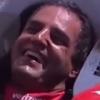Scarbs has an article describing this
http://scarbsf1.word...-in-japan-2009/
Now the rules relating to the rear wing area are as follows:
3.10 Bodywork behind the rear wheel centre line:
3.10.1 Any bodywork more than 150mm behind the rear wheel centre line which is between 200mm and 730mm above the reference plane, and between 75mm and 355mm from the car centre line, must lie in an area when viewed from the side of the car that is situated between 150mm and 350mm behind the rear wheel centre line and between 300mm and 400mm above the reference plane. When viewed from the side of the car no longitudinal cross section may have more than one section in this area.
3.10.2 Any bodywork behind a point lying 50mm forward of the rear wheel centre line which is more than 730mm above the reference plane, and between 75mm and 355mm from the car centre line, must lie in an area when viewed from the side of the car that is situated between the rear wheel centre line and a point 350mm behind it. When viewed from the side of the car, no longitudinal cross section may have more than two closed sections in this area.
Furthermore, the distance between adjacent sections at any longitudinal plane must not exceed 15mm at their closest position.
3.10.3 In order to ensure that the relationship between these two sections cannot change whilst the car is in motion they must be bridged by means of rigid impervious supports (including any adjustment mechanism) arranged such that no part of the trailing edge of the forward section may be more than 200mm laterally from a support. These rigid supports must :
- fully enclose the two complete sections such that their inner profile matches that of the two sections. Their outer profile must be offset from the inner profile by between 8mm and 30mm and may not incorporate any radius smaller than 10mm ('gurney' type trim tabs may however be fitted between the supports) ;
- not be recessed into the wing profiles (where a recess is defined as a reduction in section at a rate greater than 45° with respect to a lateral axis) ;
- be arranged so that any curvature occurs only in a horizontal plane ;
- be between 2mm and 3mm thick ;
- be rigidly fixed to the two sections. Some form of adjustment mechanism between the sections may be incorporated for the sole purpose of allowing adjustment of the sections relative to one another whilst the car is in the pits ;
- be constructed from a material with modulus greater than 50GPa.
These supports will be ignored when assessing whether the car is in compliance with Articles 3.6, 3.9.2, 3.10.1, 3.10.2, 3.10.4 and 3.10.6.
3.10.4 No part of the car between 75mm and 355mm from the car centre line may be more than 350mm behind the rear wheel centre line.
3.10.5 Any parts of the car less than 75mm from the car centre line and more than 500mm behind the rear wheel centre line must be situated between 200mm and 400mm above the reference plane.
3.10.6 No part of the car less than 75mm from the car centre line and more than 350mm behind the rear wheel centre line may be more than 400mm above the reference plane.
3.10.7 No part of the car more than 375mm from the car centre line may be more than 350mm behind the rear wheel centre line.
3.10.8 In side view, the projected area of any bodywork lying between 300mm and 950mm above the reference plane and between the rear wheel centre line and a point 600mm behind it and more than 355mm from the car centre line must be greater than 330000mm².
How can it be interpretted that a close section is allowed to be, well, not closed? The area 75mm either side of the centreline is free from this requirements, and teams have used that loophole to put slots in that area.
BMW.Sauber and McLaren have put full width slots on their wings, fed from ducts inside that centre section. Why, if it is allowed to have a hole in the rear part of the section, would it be interpretted that you can't have a hole in the leading edge?
Is this sidestep of the rule in any way related to how double diffusers came to be legal?













